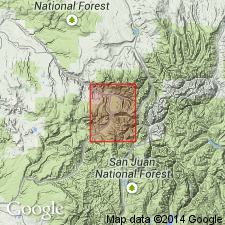
- Usage in publication:
-
- McElmo formation*
- Modifications:
-
- Original reference
- Dominant lithology:
-
- Sandstone
- AAPG geologic province:
-
- Paradox basin
Summary:
[Credited to Whitman Cross.] McElmo formation. The name here proposed for upper division of Gunnison formation, the lower division being here named La Plata sandstone. As developed in this quadrangle, consists of a variable complex of shales and sandstones, the latter much more prominent here than elsewhere. The sandstones are fine-grained, quartzose, of yellowish or gray color, and usually soft and crumbling. Some beds are locally massive, cross-bedded, and 50 feet thick, but shale partings of variable importance subdivide most of sandstone members. The shales are either reddish or greenish or variegated by a mixture of these 2 colors; they are seldom pure clay shales, but are commonly both calcareous and sandy; sandstone layers appear in the shales. Basal member is a usually highly colored shale and upper stratum is also a marked shale beneath a massive sandstone, commonly conglomeratic, which is assumed as base of Dakota Cretaceous. No fossils in Telluride quadrangle, but is assigned to Juratrias.
[Named from exposures on McElmo Creek, Montezuma Co., southwestern CO, and San Juan Co., southeastern UT.]
Source: US geologic names lexicon (USGS Bull. 896, p. 1251).

- Usage in publication:
-
- McElmo formation†
- Modifications:
-
- Abandoned
- AAPG geologic province:
-
- Paradox basin
- San Juan basin
Summary:
Upper Jurassic †McElmo formation of southwestern Colorado, northwestern New Mexico, and southeastern Utah, abandoned. Later work [post- Cross 1899] showed that the names "McElmo formation" and "La Plata sandstone" had been variously used in reports. The McElmo formation of some areas is exactly the same as Morrison formation; the McElmo formation of other areas is only upper part of Morrison formation; the so-called "Upper La Plata" being the lower part of the Morrison; the McElmo formation of still other areas included Morrison formation and Upper Jurassic deposits down to top of Entrada sandstone, the Entrada alone in those areas having been called "La Plata sandstone." The names "McElmo formation" and "La Plata sandstone" have therefore been replaced by Morrison formation and the other recently adopted subdivisions of southeastern Utah, which can also be discriminated in southwestern Colorado. See USGS Prof. Paper 183, 1936 (especially chart opp. p. 39), by A.A. Baker, C.H. Dane, and J.B. Reeside, Jr.
Source: US geologic names lexicon (USGS Bull. 896, p. 1251).
For more information, please contact Nancy Stamm, Geologic Names Committee Secretary.
Asterisk (*) indicates published by U.S. Geological Survey authors.
"No current usage" (†) implies that a name has been abandoned or has fallen into disuse. Former usage and, if known, replacement name given in parentheses ( ).
Slash (/) indicates name conflicts with nomenclatural guidelines (CSN, 1933; ACSN, 1961, 1970; NACSN, 1983, 2005, 2021). May be explained within brackets ([ ]).

